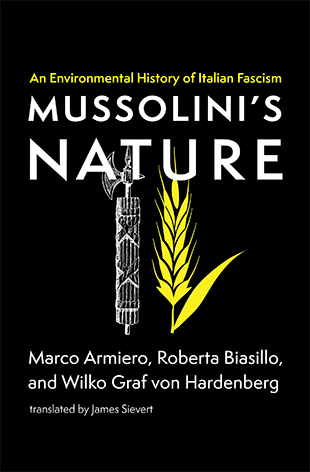


Reviewer Anna Koch - University College London
CitationThis is a timely book. Marco Armiero, Roberta Biasillo, and Wilko Graf von Hardenberg’s environmental history of Fascism speaks to two worrisome developments: the tendency of right-wing politicians to depict Italian Fascism in a benign light and the increasing pressures of the climate crisis. Published first in Italian as La natura del duce, the book’s English translation makes this important research available to a larger audience. The book debunks rose-tinted visions of Italian Fascism as a benevolent regime which has overall done much good for the country. As others have recently emphasized, such depictions remain dominant in popular memory of the regime. The recent electoral success of Giorgia Meloni's far-right party Fratelli d'Italia as well as the rise of the far-right across Europe, make historians’ efforts to challenge myths about Fascism’s supposed triumphs and achievements ever more urgent[1]. The authors critically assess Fascist narratives about nature and environmental policies, discrediting any notion that Mussolini’s regime protected nature, and exposing the realities of Mussolini’s «battles» for grain and the reclamation of land by highlighting the costs to workers in mining accidents, hazardous dam collapses, and violence in the colonies. But the book goes beyond refuting the notion that Fascism was «green», drawing a comprehensive picture of the violent and racist «political ecologies of fascism» (4).
To do so, the authors carefully analyse Fascist discourse and policy regarding the environment. They examine various projects and campaigns, some brought to fruition, still shaping Italy’s landscape and imagination, and others failed and forgotten. They cast a wide net, including urban spaces as part of the Fascist political ecology, and, importantly, analysing colonial ecologies of Fascism as part of the Italian story. While the book focuses on the Fascist period, the authors do not look at Fascism as isolated from the liberal period that preceded it, nor do they assume a radical break after the end of the war, with a last chapter examining Fascist legacies in Italy’s urban environment.
The authors begin with assessing the Duce’s relationship with, and ideas about, nature - focusing in particular on two of the many biographies written about Mussolini: Margherita Sarfatti’s 1925 The Life of Benito Mussolini and Rachele Mussolini’s La mia vita con Benito, published a little over two decades later in 1948[2]. The two accounts provide different narratives of Mussolini and his relationship with nature. While Sarfatti portrayed Mussolini as strong, a tamer of lions, and in sync with nature, Rachele, Mussolini's «peasant wife», depicted him as a family man who loved dogs and cats, and emphasised his fear of contagion. But both accounts set nature in relation to Mussolini’s body. The authors use these writings as a starting point for a deeper analysis of the links between body, gender, race, and nature in Fascist thought. The non-human world played a crucial part in the Fascist vision to remake Italy and the Italians, or in other words, shaping the landscape and engineering the people were intertwined aims. There was no room for poetic contemplation of nature’s beauty in the Fascist perception, rather nature needed to be tamed and made useful. Whether in the discourse about women and children, both considered part of nature, or landscapes, a supposed need for men’s protection thinly veils the wish for domination and what emerges is a «narrative of supremacy and subordination» (16).
Nature, according to the Fascist view, should not be left untouched - but engineered and made to follow the regime’s wishes. Technology becomes the means to fulfil this aim, and in Fascist thinking there is no dichotomy between nature and technology. They are both part of the Fascist effort to recreate and remake the land, or as the authors write, «trees and railways are both part of an infrastructure to be built rather than protected» (28). Fascists admired nature shaped and engineered by humans which becomes most apparent in Fascist ruralism, «that peculiar mixture of conservatism and repression strongly situated within a naturalized vision of Italian society» (32). The ruralist policy of the regime encompassed wide-ranging demographic plans and a repressive, conservative as well as imperialist agenda. Thus, ruralism contained several of the dominant elements of Fascist discourse around nature - and the authors return to this concept in the subsequent chapters.
Chapter 2 explores two key Fascist agricultural policies: land reclamation and the «battle for wheat». The chapter’s title Natural Wars points to how Fascists approached these projects, and links land reclamation and ruralism to Fascism’s glorification of war and wish for expansion. While the initial plans for land reclamation were wide-reaching, lack of money led to downsizing and the government carried on only with the Pontine Marshes, the biggest and most widely propagated land reclamation project. In line with the martial rhetoric of the Fascist regime, authorities perceived the Pontine Marshes as wild and undisciplined and as an environment that needed to be conquered. However, the programme to reclaim the marshes was inefficient and ran with little concern for local populations, underlining the discrepancy between the symbolic glorification of peasants and a reality in which large landowners and industrialists benefitted most from Fascist ruralism. Despite the programme’s shortcomings, it became a propaganda success, both in Italy and abroad.
The following chapter discusses the Fascist drive for autarky focusing in particular on dams, hydroelectric power, and wood gas generators. The Fascist policy of national self-sufficiency was, as Mussolini stated in 1936, a preparation for war. It also played a part in the regime’s effort to reinvent Italians by propagating a narrative of Italian frugality and ingenuity which would succeed despite a lack of resources. Both the gasogene engine and the advancement of hydroelectricity came as a response to the lack of fossil fuels in the Italian subsoil. As with the technology used for land reclamation, the advancement of hydroelectricity was not a Fascist innovation but in many ways a continuation of what had been done in liberal Italy. Appropriating existing technology, the regime claimed hydroelectricity to support a narrative of Fascism’s success in taming nature. Propaganda exhibitions and films such as the 1939 documentary Oro bianco (white gold) spread the myth of Fascist achievements. Once again, the focus remained on the extraction of resources and the ability to gain profits, with no care for the ecosystem or the local communities. When two dams collapsed with tragic consequences - at Gleno in the Lombardy Alps in 1923 and in Val Orba in 1935, the accidents were obfuscated and erased from public memory. The Fascist dream of the gasogene engine also came with costs to local populations. A lack of safety measures caused several mining accidents from 1937 to 1940 in Istria and Sardinia. In the most severe of these accidents in the Istrian mines 185 people died. Both the dam collapses and the mining accidents are absent from the many newsreels and documentaries produced by the Istituto Luce, the Fascist film company.
Continuities from the liberal period also feature in chapter 4 which, focusing on conservation policies and national parks, deconstructs a narrative of Fascist triumphs. While Fascism received praise for opening several national parks, the roots of some of these parks reach back to the liberal era. Fascism did not come up with the idea of instituting a natural park system, nor did their natural parks advance the protection of the environment in significant ways. The Fascist regime did not see the protection of nature as the main aim of natural parks but rather focused on their utilitarian value as tourist destinations and producers of resources. Fascist authorities neither placed restrictions on hunting or fishing, nor issued preservation policies. Rather than protection of nature, the construction and invention of sites that glorified and celebrated past wars and achievements became the main function of the parks.
Chapter 5 traces different narratives about the African environment as a creation of Fascist willpower, as space for settlement and the expansion of European agriculture, and as support for autarkic policies. While the Fascists promoted a narrative of hidden riches and potential in the colonies, the reality was marked by violence, waste, drought, and illness. Stories of Fascist pioneers who created fertile agricultural farms out of nothing fit neatly into the broader Fascist discourse that perceived nature as malleable by those who show willpower and endurance. Such images also linked to the notion of creating «the new Fascist man», hard and resilient. While early investors indeed found riches in the colonies by selling their land back to the state for far more than it was worth, the settling families found only hardship. Dreams of resources hidden and discoverable in the empire turned out to be nothing more than wishful thinking and the regime’s construction of an «imaginary nature» (143). Fascism’s imperial castle in the sky cost lives and damaged entire ecosystems.
The book’s last chapter shows continuities from the Fascist to the post-Fascist period, and highlights «how much of fascism remains materially present in our landscape» (163). Monuments, land reclamation projects, mines and dams remained long after Mussolini’s regime had fallen, proving its lasting impact in shaping the environment. Debates and discussions about Fascist traces in the landscape and cityscape have become prevalent in the recent decade focusing in particular on monuments. Linked to a broader transnational discussion, Italy faces the question of what to do with imperial and colonial monuments that glorify a violent, racist past but appear harmless to the uninformed observer. As the authors point out, the violent aspects of the regime became difficult to spot for many, leaving behind triumphant narratives of land reclamation, hardworking pioneers, and natural parks.
The authors conclude by stressing that Fascism did not aim to conserve or protect nature, not even in the celebrated parks. Rather, nature needed to be conquered and exploited as part of the regime’s totalitarian vision. Fascism waged war on nature, in its rhetoric as well as in its policies. The book reveals several instances in which Fascist narratives stood at odds with practices, yet the authors highlight that an «opposition between proclamations and actions, between words and deeds» (182) falls short of grasping Fascism’s political ecology. Fascist policies crucially shaped the landscape, and the transformations did at times contradict, but in others fit neatly with the narrative they spun.
Wide-reaching, innovative, and insightful, the book provides a crucial contribution to both the history of Fascism as well as Italian environmental history. In particular in comparison to the fervent discussion around Nazism and the environment, the research on Fascism’s environmental policies has so far been limited, and the book will hopefully form a starting point for further research on this topic, and potentially inspire comparative and transnational research on environmentalism and European fascism. The authors begin with the hope that the book may make it «apparent why environmental history does not end in a range of green topics but instead can spark a desire to engage all topics with new questions and perspectives». (9). Uncovering and shedding light on numerous policies, practices, and narratives, they prove that nature provides a useful prism to uncover a detailed and often striking picture of Fascism’s violent, political programme that aimed to transform both people and their environment.
[1] Paul Corner, Mussolini in Myth and Memory, Oxford, Oxford University Press, 2022.
[2] Margherita Sarfatti, The Life of Benito Mussolini, translated by Frederic Whyte, London, Thornton Butterworth Ltd., 1925; Rachele Mussolini, La mia vita con Benito, Milano, Mondadori, 1948 and Rachele Mussolini, Albert Zarca, Mussolini: An Intimate Biography by His Widow, New York, Morrow, 1974.